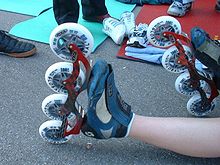Inline skating
Inline skating

Inline skates usually have 2 to 5 Polyurethane Wheels, arranged in a single line. The in-line design allows for greater speed than Rollerskates and better maneuverability. The in-line wheels coupled with boots designed for skating of various obstacles Inline-skating is practiced and performed using inline skates designed for race tracks, skate parks, Urban areas, and off-road.
Aggressive Rolling
In addition to speed, fitness, artistic, or recreational skating, some skaters prefer to skate aggressively. Aggressive skating is also often referred to by participants as rollerblading, trollerblading, nogrinderblading, mushroom blading, aggroblading, toerolling, blading or rolling and includes a variety of grinds, airs, slides and other advanced skating maneuvers. It also includes "vert", "park skating" which refer to tricks performed on almost any obstacle. Street skating specifically refers to tricks performed on non-allocated obstacles (i.e. not skate parks). There are three major types of aggressive inline skates: hard boots, soft boots, and skeletal skates (e.g. Xsjado, pronounced "shadow"). Hard boots are very rigid and often heavy compared to speed skates and recreational skates. Soft boots offer more flexibility than hard boots, but are normally just as heavy.
Aggressive inline skates could also be fitted with small hard rubber or plastic wheels, used in place of the two middle wheels. These small wheels or "anti-rockers" are used to help lock onto a ledge or rail when performing. Anti rockers enable the skater attempting the trick to stay on a rail for a longer time without the frames of the skates slipping off the ledge.
Aggressive inline saw a sharp decline in the late 1990s, but during 2000-2003 found a major resurgence for the sport when street skating became increasingly popular. At this time professional skaters including Brian Shima, Jeff Stockwell, Roman Abrate, Chris Haffey,Brian Aragon, Julien Cudot, Stephane Alfano Aaron Feinberg, and Alex Broskow among others were pushing unseen boundaries in performing seemingly impossible and dangerous stunts in mostly street settings. In addition, the IMYTA (I Match Your Trick Association) provided a venue for skaters to demonstrate these tricks. The IMYTA held contests at a street location and the skaters would have to match each trick in the first round of skating or be eliminated. The progression continued with the pool of skaters dwindling and more dangerous and difficult tricks would then be performed and a winner declared. Competitions such as the IMYTA encouraged skaters from many different countries to set up their own local real street competitions.
Some Aggressive inline brand names are as follows: Valo, Pantz, Remz, Razor, USD, Nimh, Xsjado, Roces, Deshi (merged with USD,[1]) and Rollerblade.
Powerblading

A skating category that lies somewhere between aggressive and recreational skating, powerblading, also known as urban skating, free riding free skating, includes many tricks such as jumps, slides, and grinds. The emphasis of powerblading is getting from A to B by the fastest possible route, similar to parkour, by skating quickly through city streets and negotiating all obstacles. The boots on skates suitable for powerblading tend to be more rigid for better leg support, like the aggressive skate, whilst the wheels tend to be rather big, like those found on recreational skates, and the frames short, like those found on hockey skates.
Freestyle skating
Freestyle skating is a form of inline skating performed on flatland and refers collectively to the disciplines for which competitions are organized by the International Freestyle Skaters Association. [1] Currently the IFSA has defined three disciplines which must be offered by any competition they sanction: freestyle slalom, speed slalom, and free jump. Two optional disciplines, high jump and jam, are also defined, but are at present considered optional.
Hockey
Hockey performed in a special ring on inline skates
